
On October 28, 2021, a coronal mass ejection burst forth from the Sun, affecting not just Earth but also the Moon and Mars. It’s the first time that scientists have recorded such a combo. This extraordinary event has prompted a deeper understanding of space radiation and its potential impact on future human exploration missions.
A rare and simultaneous solar event
The outburst observed on that fateful day is classified as a “ground level enhancement.” During these events, particles from the Sun possess enough energy to penetrate Earth’s magnetic bubble, which typically shields us from less energetic solar outbursts. This particular occurrence marked the 73rd ground-level enhancement ever recorded since the 1940s. However, a trifecta coronal mass ejection that has simultaneously affected Earth, Mars, and the Moon has never been recorded before.
Mars and the Moon, lacking their own magnetic fields, are more vulnerable to the influx of solar particles. Although Mars has a thin atmosphere that provides some protection against lower energy particles, the Moon lacks such defense mechanisms.
If astronauts would have been on Mars or the Moon, they would have been exposed to significant risks. These solar events can lead to radiation sickness, with doses above 700 milligray of radiation potentially causing damage to the bone marrow, leading to symptoms like infections and internal bleeding. Exposure to more than 10 gray could be fatal within two weeks, underscoring the seriousness of the risks posed by space radiation.
“Our calculations of the past ground level enhancement events show that on average one event every 5.5 years may have exceeded the safe dose level on the Moon if no radiation protection had been provided,” said scientist Jingnan Guo.

Fortunately, this time the amount of radiation measured by a constellation of spacecraft around all three cosmic bodies was not nearly close to fatal levels. During the October 2021 solar flare, NASA’s ExoMars Trace Gas Orbiter (TGO) measured 9 milligrays, 30 times more than the 0.3 milligrays detected on the surface. NASA’s Lunar Reconnaissance Orbiter (LRO) detected 31 milligrays in the Moon’s orbit while the German life science satellite Eu:CROPIS Earth orbiter detected 10 milligrays in Earth’s orbit.
In addition to the risks of radiation poisoning for astronauts, coronal mass ejections can cause havoc here on Earth. According to Daniel Brown, an associate professor in astronomy and science communication at Nottingham Trent University, when coronal mass ejections (collide with Earth’s magnetic field and atmosphere, they can trigger geomagnetic storms. These storms alter Earth’s magnetic environment, causing distortions in the magnetic fields surrounding our planet. Geomagnetic storms are classified on a scale ranging from G1 (minor) to G5 (extreme), with G3 storms considered “strong” and G4 storms labeled as “severe.”
The severity of the storm depends on various factors, including the amount of matter ejected, its speed, associated magnetic fields, and interactions with other solar particles. A more prolonged interaction leads to a stronger geomagnetic storm, increasing the likelihood of its impact on our planet.
The effects of powerful geomagnetic storms can be significant, potentially affecting electrical equipment and the power grid. On a more enchanting note, these storms may trigger the Northern Lights to be visible further south than usual.
Protecting future space travelers
Multiple spacecraft, including ESA’s ExoMars Trace Gas Orbiter, NASA’s Curiosity Mars rover, CNSA’s Chang’e-4 Moon lander, NASA’s Lunar Reconnaissance Orbiter, and DLR’s Eu:CROPIS Earth orbiter, allowed scientists to better comprehend the impact of solar outbursts on different celestial bodies.
“Currently, we live in a golden age of Solar System physics. Radiation detectors aboard planetary missions such as BepiColombo, on its way to Mercury, and Juice, cruising to Jupiter, add a much-needed coverage to study the acceleration and propagation of solar energetic particles,” remarks Marco Pinto, ESA research fellow working on radiation detectors.
Understanding these solar events is crucial for future manned exploration missions to the Moon and Mars — and there’s still much we don’t know.
The upcoming Artemis program, which aims to send astronauts to the Moon, will involve deploying a space station in lunar orbit called the Gateway. On this station, three sets of instruments, including ESA’s European Radiation Sensors Array (ERSA), NASA’s Heliophysics Environmental and Radiation Measurement Experiment Suite (HERMES), and the ESA/JAXA Internal Dosimeter Array (IDA), will monitor the radiation environment. This data will be essential for gauging the radiation risks astronauts will encounter during interplanetary journeys.
Additionally, space agencies are exploring protective measures to minimize the impact of space radiation on astronauts. The German Aerospace Center (DLR) sent two mannequins, Helga and Zohar, aboard the Artemis I test flight. Helga remained unprotected, while Zohar wore a newly developed radiation protection vest. Researchers are currently analyzing the data collected from both mannequins to better understand radiation effects.
While space exploration offers incredible opportunities, it also presents significant challenges, such as space radiation. Continuous research and data collection pave the way for human exploration missions and may one day lead to a safer and more informed journey through the vastness of space.









